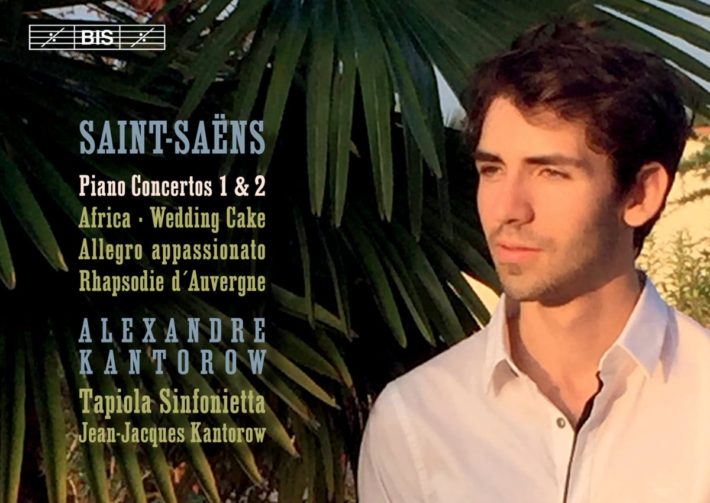As a follow up to the well-received 2019 release of Saint Saëns’ piano concertos 3-5 (reviewed here), this second installment from Alexandre Kantorow & the Tapiola Sinfonietta visits the earlier two. Interspersed are some smaller, less performed works including the Op. 76 “Wedding Cake” and the Op. 89 “Africa.”
The Op. 22 G minor might be Saint Saëns’ best known piano concerto today, but it had mixed reviews upon its 1868 premiere. However, one supporter was Franz Liszt, who found the unusual form intriguing. One example of such is the opening cadenza, and Kantorow’s is compelling. The brilliant, crystalline arpeggios drive the fiery character; the chords, thick columns of sound, remind us of crashing sea waves. Within the drama, there is also good attention to detail: the pianist reveals two different strands of voices involved in a call-and-response that eventually come together at 0:38. (Bertrand Chamayou, on his 2018 recording, takes a tempo that’s slightly brisker and gives the cadenza a more stately personality. I do prefer, ever so slightly, Kantorow’s ferocity.) But extroversion, however, isn’t the end-all-be-all: the theme at 2:10, for instance, has a contemplative lyricism while the passage at 8:58 is gentle and nearly translucent.
The bubbly Allegro Scherzando (track 2) calls for finesse where synchronicity is concerned. Soloist and ensemble are clearly comfortable with handoffs and alignment in the smallest of articulations and phrase patterns. Where Kantorow’s shine was unabashed in the aforementioned cadenza, it is now a nuanced shimmer. The balanced voicing of the chords is no easy feat, but is done in such a way that lends enough harmonic richness to the melody without compromising its buoyancy.
As far as form goes, Saint Saëns uses each movement as a means to build the concerto’s overall momentum. The culminating Presto (track 3) is a saltarello (an Italian dance from the late 1300s). With the pianist’s impeccable clarity, we can hear it in the leaping rhythmic patterns. A loss of tempo control in this movement is very much a sizeable risk and can result in musical anarchy–but even with the blazing tempo, this performance maintains an excellent pulse that doesn’t get in the way of the excitement. The welcome changes throughout in color, tone, and articulation (i.e. 0:26-0:34) offer another effective tempering factor. For instance, Kantorow’s authoritative chordal clangs in the final few minutes evoke church bells and take the momentum down just a notch–enough to leave room for a build up to a scintillating conclusion. Comparisons aplenty abound here, but one that comes to mind is Jeanne-Marie Darré’s 1955 recording with the French National Radio Orchestra. Darré’s is another pristine performance; with a hair more breathing room in the tempo, we can really hear just how much attention she gives each note.
Related Posts
- Review: Alexandre Kantorow Plays Brahms, Bartók, Liszt
- Side-By-Side Albums Review: Chamayou and Lortie Plays Saint-Saëns
- Review: Saint-Saëns – Symphonies No. 3 & Urbs Roma – Orchestre Philharmonique Royal de Liège, Kantorow
The Op. 17 D major concerto was written 10 years before Op. 22 but already shows structural experimentation in its use of cyclical form. The opening horn call becomes a recurring thematic motif and also reappears in the third movement. As a pivotal element, different ensembles take different approaches and with interesting results: Tapiola and the BBC Philharmonic (in the Louis Lortie recording) use normal and muted brass to create a conversation of timbres, whereas the Birmingham Symphony (with Stephen Hough) swaps the mute for a backstage placement, creating a more spatial effect.
While the concerto itself may not be nearly as dynamic as the G minor, the performers bring out heroism and grace in the first movement. The second movement for me was the most enjoyable. Kantorow creates long lines even in the slower moving phrases thanks to deft legatos; the orchestra’s delicate string pizzicatos also create the necessary rhythmic flow. I found the B-flat major section (1:19) especially lovely with the pianist’s tone reminiscent of small chimes.
As far as the smaller works go, Wedding Cake (track 4) is simply delightful. Kanterow’s account is elegant yet scurries humorously in the chromatic passages. The ensemble’s waltz a quarter of the way through is joyful enough to make us want to dance along.
The hybrid SACD gives us a nice surround-sound quality, bringing out the pianist’s smallest details but also the orchestra’s wide range, from airy to powerful. Jean-Pascal Vachon’s liner notes provide musical and historical insight that add valuable perspective. An impressive effort, especially where the concerti are concerned–enthusiastically recommended.

Saint-Saëns – Piano Concertos 1 & 2
Alexandre Kantorow – Piano
Tapiola Sinfonietta
Jean-Jacques Kantorow – Conductor
BIS Records, SACD Hybrid BIS-2400
Recommended Comparisons
Read more classical music reviews or visit The Classic Review Amazon store
Follow Us and Comment:
[wd_hustle id=”HustlePostEmbed” type=”embedded”]











